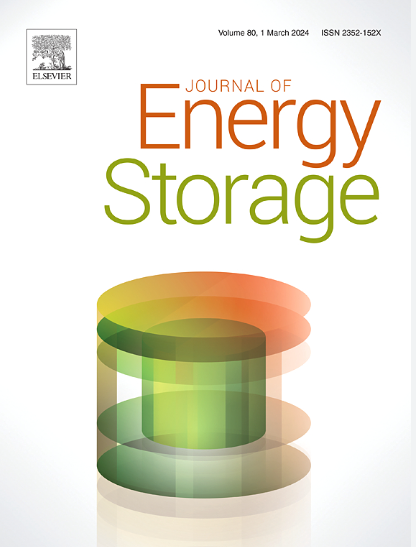基于能源、用能和生态用能分析的相变材料的数据中心太阳能冷却系统优化:一个案例研究
IF 8.9
2区 工程技术
Q1 ENERGY & FUELS
引用次数: 0
摘要
这项研究解决了使用太阳能来满足数据中心冷却需求的挑战,太阳能本身就是间歇性的,并且依赖于天气。为了克服这个问题,开发了一种先进的太阳能冷却系统,将热能储存(TES)与相变材料(PCMs)集成在一起,以确保在非太阳能时段保持一致的热量供应。该系统利用三种pcms(己二酸、对苯二甲酸二甲酯和亚硫酸)的热力学性质,根据它们的密度、熔合潜热、熔化温度和比热容进行评估。采用遗传算法(GA)进行多目标优化,然后采用TOPSIS方法,以最小化成本和最大化效率来提高系统性能。在所研究的材料中,对苯二甲酸二甲酯在充电时的火用效率最高,达到20.36%,是最适合应用的PCM。优化后的系统的性能系数(COP)为0.79,运行成本为56.31美元/小时,在夏季辐射条件下效率最高。季节性分析显示,与秋季相比,夏季的能源效率提高了67.57%,突出了太阳能可用性的影响。结果强调了PCM热力学特性和TES设计在提高系统弹性和成本效益方面的关键作用。这项研究为将可再生能源集成到高效冷却系统中设定了基准,为数据中心的热管理提供了实用和可持续的解决方案。本文章由计算机程序翻译,如有差异,请以英文原文为准。
Optimization of solar-powered cooling systems for data centers using phase change materials based on energy, exergy, and eco-exergy analysis: A case study
This study addresses the challenge of meeting the cooling demands of data centers using solar energy, which is inherently intermittent and weather-dependent. To overcome this issue, an advanced solar-powered cooling system is developed, integrating thermal energy storage (TES) with phase change materials (PCMs) to ensure a consistent thermal supply during non-solar hours. The system utilizes the thermodynamic properties of three PCMs—Adipic acid, Dimethyl terephthalate, and Suberic acid—evaluated based on their density, latent heat of fusion, melting temperature, and specific heat capacity. A multi-objective optimization using a genetic algorithm (GA), followed by the TOPSIS method, is employed to enhance system performance by minimizing cost and maximizing efficiency. Among the materials studied, Dimethyl terephthalate exhibits the highest exergy efficiency of 20.36 % during charging, making it the most suitable PCM for the application. The optimized system achieves a coefficient of performance (COP) of 0.79 and an operating cost of $56.31 per hour, with peak efficiency observed during summer radiation conditions. Seasonal analysis reveals a 67.57 % improvement in exergy efficiency during summer compared to autumn, highlighting the impact of solar availability. The results underscore the critical role of PCM thermodynamic properties and TES design in enhancing system resilience and cost-effectiveness. This research sets a benchmark for integrating renewable energy into high-efficiency cooling systems, offering a practical and sustainable solution for thermal management in data centers.
求助全文
通过发布文献求助,成功后即可免费获取论文全文。
去求助
来源期刊

Journal of energy storage
Energy-Renewable Energy, Sustainability and the Environment
CiteScore
11.80
自引率
24.50%
发文量
2262
审稿时长
69 days
期刊介绍:
Journal of energy storage focusses on all aspects of energy storage, in particular systems integration, electric grid integration, modelling and analysis, novel energy storage technologies, sizing and management strategies, business models for operation of storage systems and energy storage developments worldwide.
 求助内容:
求助内容: 应助结果提醒方式:
应助结果提醒方式:


